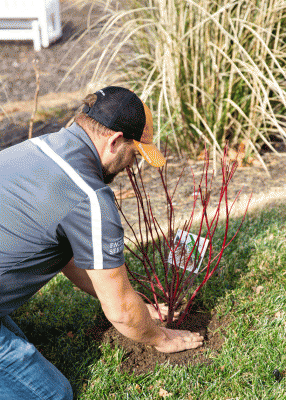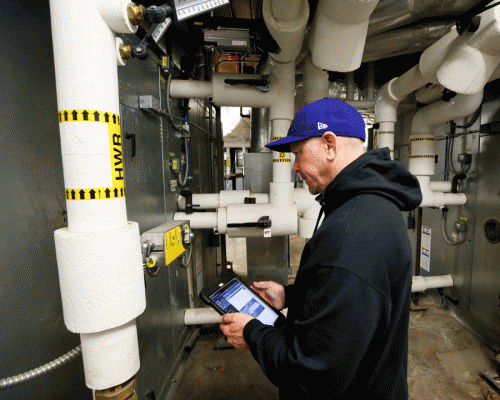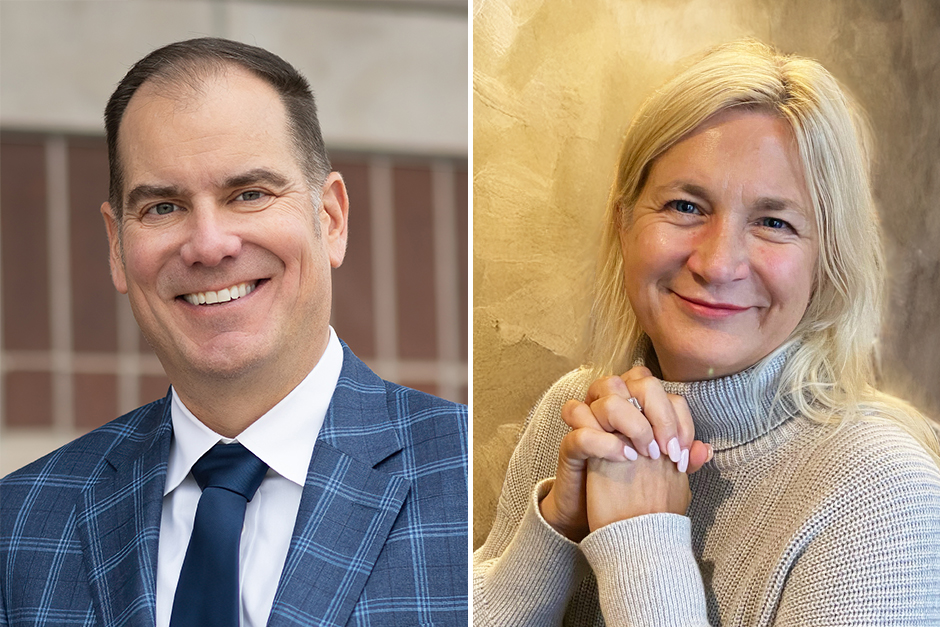Caring for the campus
Think for a moment about what drew you to Cornell.

It’s nearly impossible to do without visualizing the idyllic hilltop setting, the park-like grounds, and the arrangement of brick buildings connected by the Ped Mall. We often take for granted that everything that happens here—the teaching, learning, performing, competing, living, and working—depends on the smooth functioning of the physical campus.
A team is on-call 24–7 to make this happen. Led by Director Luke Fischer with Assistant Director Cari Morgan, that 17-person team is responsible for keeping buildings safe, warm, and dry, and the grounds clean, cut, and comforting. This includes a great deal of behind-the-scenes functions like managing utilities, event support, and responding to approximately 5,000 work orders per year.
“Basically we love, serve, and care for the campus,” Fischer says.
If you have noticed a marked improvement in campus buildings and grounds in the past 12 years, it’s because President Jonathan Brand made it a priority. Renovations, new construction, and the overall beauty of the historic campus were prominent in the two strategic plans to date under his presidency—and follow important work done on campus before him.
“We love our campus,” Brand says, repeating the strong sentiment Fischer makes about the college’s home. “We cherish and prize our campus, and that makes what Facilities does even more important. We operate like a small city with plumbing, lighting, carpentry, HVAC, and grounds. We have tree plans, lighting plans, and accessibility plans. And then there’s the look and feel of our campus. We want not just alumni but prospective students and their families to come on this campus and get goosebumps.”
Brand says Facilities staff take to heart the central focus of the most recent strategic plan: recruiting, retaining, and supporting students.

“One of the things I admire about the Facilities staff is that they are so engaged with our students. They’ll stop and talk to somebody. That is an emblem of a great Cornellian. They’re living our strategic goals and values—making campus a welcoming place for everyone, recruiting and retaining students, and really serving and supporting them.”
Among students, Donivan Jones ’24 has one of the highest rates of facility work order requests. As Student Senate President he often needs event setup or assistance with projects such as installing hammocks and adding holes to the disc golf course.
“It surprised me how much they were willing to work with a student,” he says. “They were wonderful to bounce ideas off, as well as actually getting things done.”
Saving buildings and squirrels
Taking care of 68 buildings and 129 acres on a National Historic Register campus is a challenge, even with a team of 13 maintenance techs, two directors, a construction projects manager, an office coordinator, and the eyes and ears of Campus Safety during nights and weekends.

Some tasks evolve through the seasons, from planting and pruning to snow removal to mowing to prepping buildings for move-in day. Monitoring, maintenance, and long-term planning is ongoing. So is maintenance of the large array of mowers, chain saws, trimmers, leaf blowers, specialty equipment, a carpentry shop, plumbing shop, and 16 vans and trucks filled with everyday hand tools and supplies.
Work orders submitted by students, faculty, and staff keep the job interesting and unpredictable—like the day a team member had to trap a campus squirrel in order to cut off the cone-shaped DQ® lid stuck around its neck.
“There is always a curveball that makes the day interesting,” Morgan says. “People are not coming to us to tell us that everything is working perfectly, so it is always an interesting challenge to work with our team and others on campus to fix situations. We get to help students, faculty, and staff make things better in their environments.”
Handling events and catastrophes
The Facilities team is also the backbone of major campus events including Homecoming and Commencement. Their team provides planning, setup, and teardown—which, like so much of what they do, often goes unnoticed when done well.

Catastrophic challenges are rare but in 2020 there were two. The pandemic closed classrooms in the spring, and Facilities mobilized to provide campuswide protections (barriers, filters, sanitizers, cleaning agents) in time for a fall reopening. Then just before school was to start, a derecho hit Mount Vernon with winds up to 140 mph, damaging buildings and causing the loss of 217 trees. Facilities again refocused and led the process of rebuilding the campus—an ongoing project.
Also under their purview is oversight of new construction, renovation, and repairs as complicated as restoring the 1882 King Chapel with historical integrity. New construction brings added square footage to maintain. Since 2018 building capacity has increased by 74,333 square feet with the Russell Science Center footprint and additions to the Richard and Norma Small Athletic and Wellness Center.
The aging 170-year-old campus poses its own challenges. Addressing deferred maintenance and taking on routine projects, like tuck pointing, insulating, and roofing, all need to happen along with the day-to-day and seasonal routines—with everything competing for budget dollars.
The bottom line, Fischer says, is that Facilities exists to make sure the college can meet its mission: “We take care of all the problems so students can learn.”
21st century historic campus
In the last few years technology has taken a larger role, with a recent move to all-electronic work orders, asset tracking, and capital management. All maintenance techs carry an iPad to track their work orders, order parts, and access building controls, building plans, and equipment schematics. The system tracks expenses to help determine whether to repair or replace the equipment.

Fischer and Morgan can watch the system from their laptops at home to make adjustments online or to determine when an issue requires an on-site solution.
As amazing as this sounds, technology poses its own challenges. It expands faster than the team can reasonably implement or train for. And some new equipment allows only certified technicians to provide maintenance.
Large infrastructure improvements made four years ago reduced energy usage over 20% by installing high-efficiency boilers to remove the final eight buildings from the old campus steam plant and by upgrading nearly every building with LED lighting. One small example of the results is that once or twice a week lighting work orders have dwindled to once per quarter. Fischer is looking for additional sustainability models and recently contracted the purchase of natural gas, saving the college up to $300,000 a year.
Getting things done

Gary Stinocher started as a maintenance technician in 2012 and says he has seen a steady improvement in the grounds and buildings since then. That’s due to two things, he says: resources and people.
“Last summer a coworker needed to have his building prepared for move-in after he lost both of his parents within two weeks,” Stinocher says. “Everybody pulled together and we got it ready in one day.” When the coworker returned, his building, Pauley-Rorem, had been checked from top to bottom, repairs made, filters changed, painting done, locks in working order, and beds in place.
A well run organization is fundamentally service-oriented, says President Brand, and he is most proud of the Facilities team for modeling that.
“I have a really special feeling about them because they do so much to support this college, more than people know,” Brand says. “ Our Facilities staff works hard. They want to support the students as well as our faculty, staff, guests—frankly anyone who comes onto our campus—and they get things done.”



